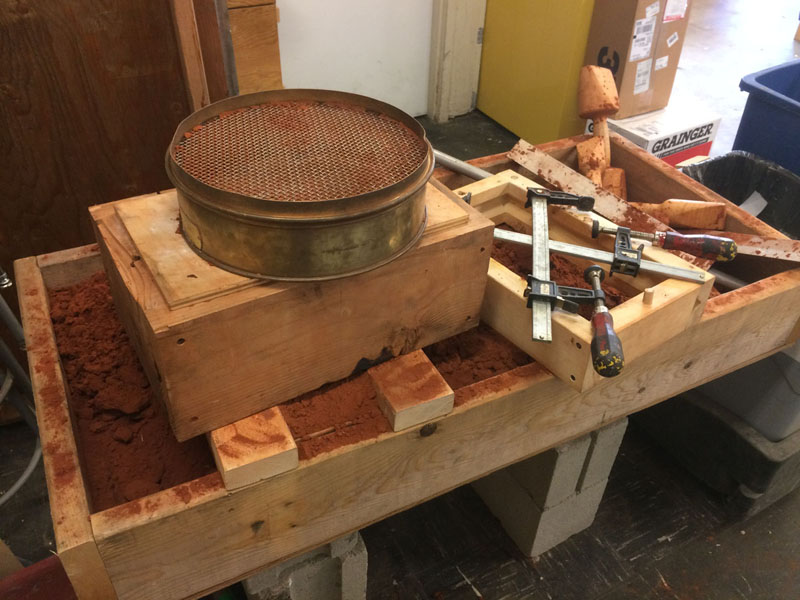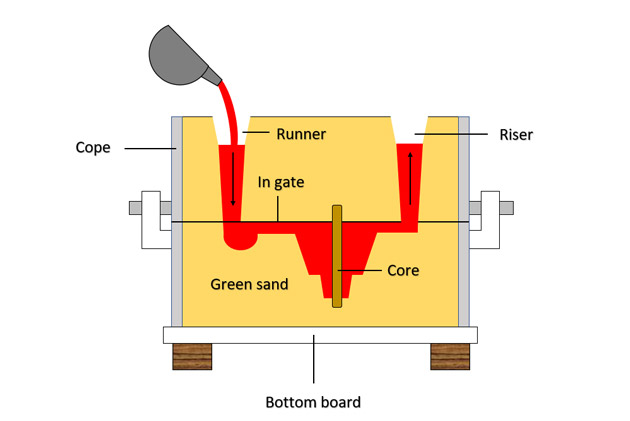Aluminum Foundry Wisconsin supports modern casting practices
Exactly How Aluminum Foundry Adds To Improvements in Aerospace Design
Aluminum factories are indispensable to innovations in aerospace engineering. They produce light-weight, high-strength parts that are vital for modern aircraft. Via advanced spreading strategies, these foundries develop complicated geometries that improve structural integrity. Furthermore, the advancement of superior Aluminum alloys sustains the market's emphasis on fuel efficiency and sustainability. Obstacles remain in the manufacturing process. Recognizing these factors reveals the profound effect of Aluminum on aeronautics's future.
The Relevance of Lightweight Materials in Aerospace Style
As the aerospace sector proceeds to evolve, the relevance of light-weight materials comes to be progressively apparent. The need for efficiency and sustainability drives designers to prioritize making use of materials that minimize general weight without compromising structural stability. Lightweight products, particularly Aluminum, play a crucial function in enhancing fuel efficiency, improving payload ability, and raising the overall performance of aircraft.
In addition, the integration of these products enables ingenious styles, making it possible for producers to create more wind resistant forms that can stand up to severe problems. The reduction in weight not only decreases functional expenses yet likewise adds to a lowered ecological footprint, lining up with global initiatives toward sustainability in air travel.
Advanced Spreading Techniques in Aluminum Foundries
Advanced spreading techniques in Aluminum factories play an essential function in aerospace engineering by allowing the manufacturing of light-weight and precise parts. Advancements in mold layout and precision spreading processes are essential in achieving optimal efficiency and architectural stability. Additionally, the growth of light-weight alloys enhances the overall effectiveness and efficiency of aerospace applications.
Ingenious Mold And Mildew Style
Cutting-edge mold and mildew design plays a necessary duty in the efficiency and effectiveness of Aluminum factories, specifically within the aerospace sector. By leveraging sophisticated materials and techniques, modern mold and mildews can be crafted to withstand heats and pressures, making certain peak performance during the spreading procedure. These styles typically incorporate complex geometries that permit the manufacturing of lightweight yet structurally sound elements, vital for aerospace applications. Furthermore, the use of computer-aided design (CAD) software application helps with exact modeling, enabling foundries to mimic and refine mold and mildew styles before physical manufacturing starts. This not just boosts the quality of cast parts but also lowers waste and preparation, leading to significant cost financial savings. Overall, cutting-edge mold layout is a keystone of progress in Aluminum Foundry innovation for aerospace engineering.
Precision Casting Processes
The efficiency of innovative mold layouts flawlessly integrates with accuracy spreading procedures, which are necessary for creating top notch Aluminum parts in aerospace engineering. These procedures, including sand casting, pass away spreading, and financial investment casting, assure the production of complex geometries with tight tolerances. Advanced methods like vacuum cleaner casting and pressure die casting improve the stability and surface area finish of the end products. Precision casting reduces product waste while optimizing the mechanical residential or commercial properties of Aluminum, essential for aerospace applications. On top of that, using real-time tracking and advanced simulation tools throughout the casting procedure enables prompt changes, resulting in boosted quality assurance. Collectively, these accuracy spreading processes position Aluminum factories at the center of aerospace development, supporting the market's demand for dependability and performance.
Lightweight Alloy Development
As aerospace engineers look for to enhance gas performance and efficiency, lightweight alloy growth comes to be an essential focus in Aluminum foundries. These foundries use innovative spreading techniques to produce alloys that offer premium strength-to-weight ratios. Technologies in alloy make-up, including the incorporation of aspects like lithium and magnesium, allow the manufacturing of materials that withstand extreme problems while minimizing total airplane weight. Methods such as die casting and investment spreading assist in the accuracy production of complicated forms, which are important for aerospace applications. Additionally, recurring research aims to optimize these alloys for improved mechanical homes and boosted sturdiness. By focusing on lightweight alloy growth, Aluminum foundries considerably add to the evolution of aerospace design, leading the way for much more sustainable and efficient aircraft styles.

Enhancing Structural Honesty With Aluminum Parts
Aluminum components offer substantial advantages in improving structural integrity within aerospace design. Their light-weight nature adds to total effectiveness while keeping stamina, which is crucial for airplane performance. In addition, the tension resistance residential or commercial properties of Aluminum assistance guarantee the longevity and dependability of aerospace structures under various functional conditions.
Lightweight Material Benefits
While standard products commonly jeopardize weight for strength, making use of Aluminum elements in aerospace engineering offers significant advantages in architectural honesty. Aluminum's light-weight nature adds to total style performance, permitting more structured airplane that take in much less fuel, thereby boosting sustainability. The material's outstanding strength-to-weight proportion assurances that parts preserve resilience without including unneeded mass. This quality cultivates enhanced efficiency and agility in trip, in addition to maximized payload capacities. Furthermore, Aluminum's resistance to corrosion extends the lifespan of aerospace structures, reducing maintenance expenses and improving safety. As suppliers progressively adopt Aluminum alloys, the aerospace market experiences a transformative shift towards extra efficient and reliable engineering options that prioritize both efficiency and ecological responsibility.
Anxiety Resistance Residences
Although numerous materials possess special residential properties, Aluminum's phenomenal tension resistance attracts attention as an essential consider boosting the architectural honesty of aerospace components. This resistance plays an important role in making certain that airplane can hold up against numerous functional stress and anxieties, consisting of fatigue, effect, and environmental problems. Aluminum alloys, particularly engineered for aerospace applications, display high tensile toughness while maintaining light-weight attributes, making it possible for engineers to make extra reliable frameworks - Aluminum Foundry. Additionally, the ability of Aluminum to sustain cyclic loading without considerable contortion adds to the long life and integrity of aerospace parts. As developments continue in Aluminum Foundry methods, the growth of stress-resistant Aluminum elements promises more improvements in performance, security, and effectiveness across the aerospace sector, strengthening Aluminum's duty as a favored material in modern-day engineering
Gas Efficiency Improvements Driven by Aluminum Innovations
As the aerospace sector seeks to enhance gas effectiveness, ingenious uses of Aluminum have actually become a necessary service. Aluminum's light-weight nature especially minimizes aircraft weight, enabling reduced gas usage during flight. This reduction in weight is vital, as also small decreases can bring about considerable improvements in general fuel economic situation.
Advanced Aluminum alloys, made for improved toughness and sturdiness, enable makers to develop components that preserve structural stability while decreasing mass - Aluminum Foundry. Additionally, the assimilation of Aluminum in airframes and engine parts promotes improved aerodynamics, adding to reduced drag and raised efficiency
The adoption of Aluminum in aerospace not just meets the demand for fuel-efficient style yet also lines up with regulatory pressures for lower discharges. As these innovations remain to evolve, they play a considerable duty in setting new criteria for fuel efficiency, guaranteeing that the aerospace field can meet growing environmental and financial challenges.

The Function of Aluminum in Sustainable Aviation Practices
The enhancing emphasis on sustainable aviation techniques has actually placed Aluminum as an essential product in the quest for greener aircraft design. Known for its lightweight properties, Aluminum significantly minimizes aircraft weight, leading to lower fuel intake and discharges. Its recyclability even more enhances its sustainability account, as Aluminum can be recycled forever without loss of high quality. This particular supports a circular economic situation within the aeronautics market, check this site out lessening waste and source exhaustion.
Advancements in Aluminum alloys have improved their stamina and deterioration resistance, enabling for longer solution life and reduced upkeep requirements. These technologies promote the advancement of extra reliable aircraft frameworks, contributing to general sustainability initiatives. you can try these out Furthermore, Aluminum's thermal conductivity plays an important role in energy-efficient layouts, enhancing systems such as warmth exchangers. Collectively, these features emphasize Aluminum's critical duty in progressing lasting aviation, straightening with worldwide campaigns focused on reducing the environmental influence of air travel.
Obstacles Faced by Aluminum Foundries in Aerospace Manufacturing
While Aluminum factories play an important function in aerospace production, they deal with considerable difficulties that can impact manufacturing performance and top quality. One major difficulty is the rigorous quality control criteria called for in the aerospace industry. Any defect can jeopardize security and efficiency, demanding strenuous evaluation procedures that extend production timelines. Additionally, factories typically contend with fluctuating raw material costs, which can affect pricing and profitability. The complexity of Aluminum alloys made use of in aerospace applications more makes complex the production process, as exact formulations are vital for attaining wanted mechanical residential properties. Experienced labor scarcities hinder the ability to maintain premium production levels. Ecological policies impose restrictions on exhausts and waste management, needing shops to spend in sustainable techniques, which can be cost-prohibitive. These variables jointly produce a landscape where Aluminum foundries have to continually adapt to meet the progressing demands of aerospace production while making certain safety and security and compliance.
Future Fads in Aluminum Applications for Aerospace Design
With advancements in innovation and enhancing needs for efficiency, the future of Aluminum applications in aerospace engineering is positioned for significant transformation. The integration of cutting-edge Aluminum alloys and composites is anticipated to enhance strength-to-weight ratios, leading to even more fuel-efficient aircraft styles. On top of that, developments in additive production strategies will enable the manufacturing of complicated Aluminum structures that were previously difficult, enhancing performance and reducing waste.

Lasting practices will play a crucial role, with a growing emphasis on recycling Aluminum to reduce ecological impact. The aerospace industry is likely to accept smarter producing procedures, such as automation and expert system, ensuring higher quality and accuracy in Aluminum elements. Moreover, partnerships in between Aluminum shops and aerospace business will certainly cultivate research study and growth, leading the way for new applications that meet the stringent requirements of contemporary aerospace design - Aluminum Foundry. Generally, the future looks you could try these out promising for Aluminum's role fit the skies
Often Asked Inquiries
What Are the Ecological Effects of Aluminum Production in Aerospace?
The environmental influences of Aluminum manufacturing in aerospace include substantial power usage, greenhouse gas emissions, and environment interruption. Furthermore, mining processes can lead to dirt deterioration and water contamination, increasing worries about sustainability and eco-friendly equilibrium.
Exactly How Does Aluminum Compare to Other Materials in Aerospace Applications?
Aluminum uses a special combination of lightweight residential properties, deterioration resistance, and cost-effectiveness contrasted to other products. Its high strength-to-weight proportion makes it especially advantageous for aerospace applications, improving fuel performance and general performance in airplane style.
What Qualifications Do Aluminum Foundry Workers Demand for Aerospace Projects?
Aluminum Foundry workers need specialized training in metallurgy and casting strategies, in addition to understanding of aerospace sector standards. Certifications in high quality control and safety procedures are additionally important to guarantee conformity with stringent aerospace job needs.
Are There Any Safety And Security Worry About Making Use Of Aluminum in Aerospace Engineering?
Security worries concerning Aluminum in aerospace engineering include susceptibility to anxiety, deterioration, and exhaustion fractures. Proper therapy and alloy selection are necessary to alleviate these threats, ensuring structural honesty and total safety in aerospace applications.
How Does Aluminum Recycling Benefit the Aerospace Industry?
Aluminum reusing greatly profits the aerospace sector by lowering material costs, minimizing ecological influence, and preserving power. This sustainable technique boosts the sector's effectiveness while promoting using lightweight, high-performance parts in aircraft production.
Advanced spreading techniques in Aluminum factories play an important function in aerospace engineering by making it possible for the production of specific and lightweight components. Ingenious mold design plays an important function in the effectiveness and effectiveness of Aluminum shops, particularly within the aerospace sector. As aerospace designers seek to boost gas effectiveness and efficiency, lightweight alloy growth ends up being a crucial emphasis in Aluminum foundries. Aluminum alloys, especially engineered for aerospace applications, show high tensile strength while preserving lightweight qualities, making it possible for designers to develop a lot more effective structures. Partnerships between Aluminum shops and aerospace companies will certainly promote research and advancement, paving the way for new applications that fulfill the strict demands of modern-day aerospace engineering.